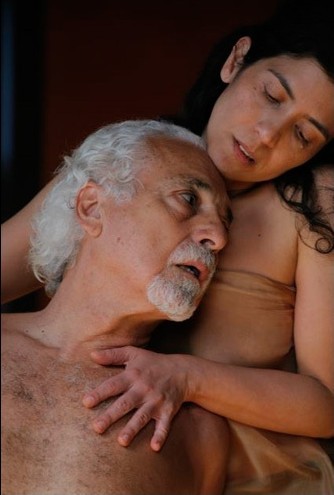Daria Martin
28 Jan - 22 Mar 2009
NEW COMMISSIONS
DARIA MARTIN
"Minotaur"
1/28/09 - 3/22/09
Third Floor
Minotaur is a new 16 mm film created by Daria Martin depicting a duet choreographed by the legendary dance and movement pioneer Anna Halprin based on the 1886 sculpture Minotaur by sculptor Auguste Rodin. Martin has carefully edited the film to juxtapose the movements of the two dancers with close-up views of Rodin's sculpture, images of the sculpture in a book, views of the wooded exterior of Halprin’s Northern California studio where the dance takes place, and shots of Halprin herself. In doing so, she creates a complex and multilayered synthesis of various art forms—film, dance, and sculpture—while simultaneously meditating on the process through which art is made, and the shifting sexual dynamics between men and women as embodied in both the sculpture and Halprin's performative re-imagination of it.
According to classical Greek myth, the Minotaur was a monster, the half-bull, half-human offspring of the King of Crete, Minos. It was confined to the center of a labyrinth that confounded the young men and women who were ritually sacrificed to the beast. This myth provided substantial inspiration for Rodin and numerous artists of the twentieth century, including Max Ernst, Pablo Picasso, Man Ray, and Robert Morris, among others, as well as dancers like Martha Graham. Modernist representations of the Minotaur myth have concentrated either on the formal dynamics of the labyrinth, or on the beast itself as a raw force at odds with its surroundings and fate, or sexually overpowering a female subject.
Halprin’s dance as captured by Martin reconsiders the relationship between a male Minotaur figure, performed by a robust older dancer, and a younger woman as his captive nymph. Shifting between their faces and intertwined bodies, the camera moves around them to capture their intensely sensual and achingly deliberate movements. Mysterious reflections on the surface of the bronze sculpture and views of the surrounding wooded landscape are intercut with additional footage of Halprin as she pours through images of Rodin’s sculptures that echo the shifting positions of the dancers. As the performance reaches its climax, the nymph establishes her independence from the Minotaur, circumnavigating him, and ultimately meeting his defeated gaze with a look that changes from calm self-assuredness to a sadness bordering on melancholy. This look, directed ostensibly at the Minotaur, is redirected through a strategic jump cut to meet Halprin’s eyes. The camera then pans down the choreographer’s face to reveal a wry grin that suggests an air of personal, aesthetic, and perhaps even sexual satisfaction.
Minotaur features many characteristics of Martin’s filmmaking in the past decade, including intertwining unconventional performance and music; cinematically self-reflexive techniques; and a rigorous emphasis on materials, surfaces, and sculptural stagecraft. The complex layering of these elements challenges a conventional understanding of cinema as an inherently disembodied cultural form. The film extends her placement of objects, bodies, sounds, and movements within a sculpturally engaged filmic space to render our visual experience palpably and often uncomfortably manifest.
DARIA MARTIN
"Minotaur"
1/28/09 - 3/22/09
Third Floor
Minotaur is a new 16 mm film created by Daria Martin depicting a duet choreographed by the legendary dance and movement pioneer Anna Halprin based on the 1886 sculpture Minotaur by sculptor Auguste Rodin. Martin has carefully edited the film to juxtapose the movements of the two dancers with close-up views of Rodin's sculpture, images of the sculpture in a book, views of the wooded exterior of Halprin’s Northern California studio where the dance takes place, and shots of Halprin herself. In doing so, she creates a complex and multilayered synthesis of various art forms—film, dance, and sculpture—while simultaneously meditating on the process through which art is made, and the shifting sexual dynamics between men and women as embodied in both the sculpture and Halprin's performative re-imagination of it.
According to classical Greek myth, the Minotaur was a monster, the half-bull, half-human offspring of the King of Crete, Minos. It was confined to the center of a labyrinth that confounded the young men and women who were ritually sacrificed to the beast. This myth provided substantial inspiration for Rodin and numerous artists of the twentieth century, including Max Ernst, Pablo Picasso, Man Ray, and Robert Morris, among others, as well as dancers like Martha Graham. Modernist representations of the Minotaur myth have concentrated either on the formal dynamics of the labyrinth, or on the beast itself as a raw force at odds with its surroundings and fate, or sexually overpowering a female subject.
Halprin’s dance as captured by Martin reconsiders the relationship between a male Minotaur figure, performed by a robust older dancer, and a younger woman as his captive nymph. Shifting between their faces and intertwined bodies, the camera moves around them to capture their intensely sensual and achingly deliberate movements. Mysterious reflections on the surface of the bronze sculpture and views of the surrounding wooded landscape are intercut with additional footage of Halprin as she pours through images of Rodin’s sculptures that echo the shifting positions of the dancers. As the performance reaches its climax, the nymph establishes her independence from the Minotaur, circumnavigating him, and ultimately meeting his defeated gaze with a look that changes from calm self-assuredness to a sadness bordering on melancholy. This look, directed ostensibly at the Minotaur, is redirected through a strategic jump cut to meet Halprin’s eyes. The camera then pans down the choreographer’s face to reveal a wry grin that suggests an air of personal, aesthetic, and perhaps even sexual satisfaction.
Minotaur features many characteristics of Martin’s filmmaking in the past decade, including intertwining unconventional performance and music; cinematically self-reflexive techniques; and a rigorous emphasis on materials, surfaces, and sculptural stagecraft. The complex layering of these elements challenges a conventional understanding of cinema as an inherently disembodied cultural form. The film extends her placement of objects, bodies, sounds, and movements within a sculpturally engaged filmic space to render our visual experience palpably and often uncomfortably manifest.

